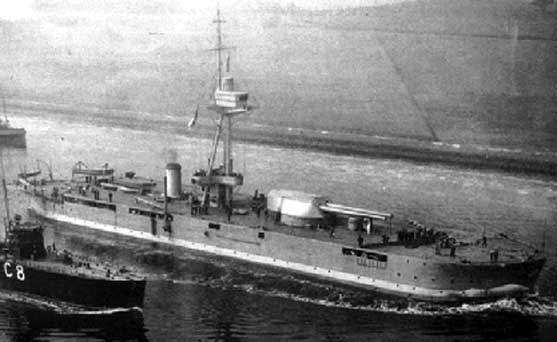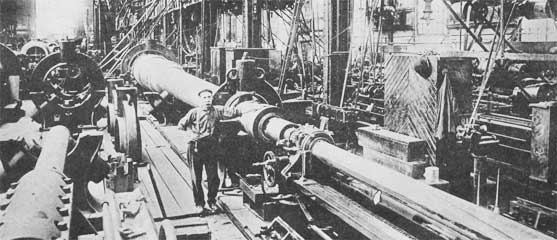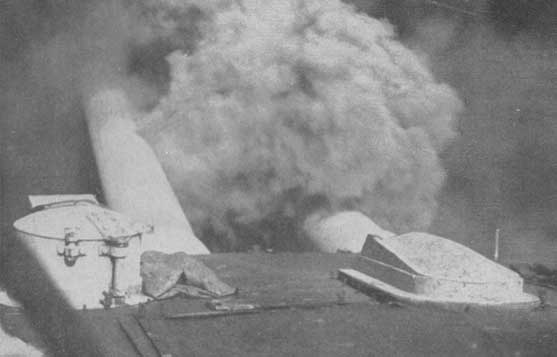| Royal Navy Monitors:
The Americans
By David Hughes
September 2015
As soon as the First World War was declared Churchill and Fisher, the First Lord and First Sea Lord of the Admiralty, erupted into a buying spree which included a determined attempt to commission ships capable of "taking the war to the enemy shore." The shore would turn out to be Flanders, but when ordered their monitors were intended for targets as disparate and distant as the Dardanelles and the Baltic. Those built in the first two years of the war were very similar, mainly distinguished by the type of heavy gun they carried.
They were coast attack ships, reversing the prime function of most previous classes, such as the small battleships built by the Nordic nations and the long line of low-freeboard monitors produced by the United States Navy after the Civil War. Only the Italian Navy took a similar approach with smaller monitors, but ones that could only hug the Adriatic Coast and bombard enemy positions east of Venice. To reach their target they were given adequate living quarters (in fact quite luxurious compared with many other warships) and enough freeboard to keep the ship dry as well as safe, while they were to be capable of making at least ten knots. The last turned out to be highly ambitious in many cases. A shallow draft was an obvious priority but other aspects of their design are not as clear.
All but the very last were built in merchant yards, many at Harland and Wolff at Belfast which had previously specialised in large passenger liners. It was soon discovered that two big monitors could be quickly laid down on a shipway designed for an Olympic or Titanic. This meant that they would not take up space in specialised warship yards. They were also given merchant-ship engines for the same reason.
 The monitor Raglan, a decidedly odd-looking warship. The monitor Raglan, a decidedly odd-looking warship.
They were designed to be expendable vessels, usually with reservist crews, whose loss was less likely to cause public alarm than that of even a light cruiser, let alone an obsolescent pre-dreadnought. This did not make them less essential. In the Great War the Royal Navy did not encourage assigning modern capital ships to bombardment duties; one of the serious charges laid against Winston Churchill was that he had risked the Queen Elizabeth and battle cruisers against the Turkish guns and mines at the Dardanelles. This was no minor issue as, unlike the situation in Second World War, the Royal and United States Navies did not have a clear superiority in modern capital ships over their enemies.
The most important question was the availability of guns. In 1914 eight new 14-inch guns were sitting in America, stranded when the British blockade stopped them from reaching Germany where they were to be installed on the battle cruiser Salamis, intended for Greece. They were offered to Britain — at a highly inflated price — and installed in the first four monitors built. As a compliment Churchill ordered them named after Americans, the Admiral Farragut, General Grant, Robert E. Lee and Stonewall Jackson. He was always impulsive, apart from having an American mother, and in this case had misread a situation in which Washington was immersed in a state of anxious isolationism. Fearful that these names would draw attention to the transfer of the guns, the diplomats insisted that they be changed. The vessels became HMS Abercrombie, Havelock, Raglan and Roberts, establishing a system of naming most monitors after British (and French) generals.
 Bethlehem Steel's foundry, with a 14-inch gun under construction. Bethlehem Steel's foundry, with a 14-inch gun under construction.
The guns over which there had been such a fuss were considered adequate weapons, with a maximum range (always the primary concern for a monitor) of 19,900 yards from an elevation of 15 degrees. Royal Navy opinion was mixed. The long tube life was admired (they could shoot twice the 300 rounds expected of British guns), but there were serious questions over the low safety factor (there were fewer inter-locks than in British practise) and inferior construction. It seemed that the hoops used to lock the barrel sections weakened so that both velocity and accuracy suffered. Four replacement barrels had to be supplied by the United States Navy and two built in Britain, even though the original guns were not worn out.
But this was minor compared with their failure to reach anything like the designed speed of 10 knots. When new they could barely make seven knots, and after a couple of years in service Roberts usually crawled along at just over five knots — no more than a fast walk! All this was due to the rush to get them in service which prevented any tests of their underwater form from being carried out, as well as the enormous bulges (15 feet wide on either side) installed to protect against submarines and reduce their draft. In contrast protection was good, with a highly sloped (about 45 degrees) four-inch belt along the entire length which also covered the entire deck over the magazines.
As soon as they were ready the monitors were sent to the Dardanelles. By July 1915 all were on station, their invulnerability to submarines and their small crews making them much more appropriate than the pre-dreadnought battleships previously used. They appear to have done well, often shooting at ranges of up to 27,000 yards by the simple expedient of flooding the offshore bulge and so increasing the actual elevation of the guns. Their armament was increased by a single 6-inch aft and some light anti-aircraft guns. Strangely the 6-inch in Roberts had a high-angle mounting making it the largest (and certainly the least effective) anti-aircraft gun ever used by the Royal Navy!
When the peninsula was evacuated Havelock and Roberts were sent home, but saw little further action. The reason was that their guns were no longer good enough for the Flanders coast. Their range was less than the 12-inch or even 9.2-inch guns mounted in most monitors which meant that they would be very vulnerable to German coastal batteries. Instead they were assigned a duty that was the opposite of their design — coast-defence ships stationed at Lowestoft and Yarmouth in case they were again raided by German battle cruisers.
The other two remained in the Mediterranean, Abercrombie bombarding on the Salonika front together with Raglan, the latter also shelling Gaza when the Turkish line was broken in the attack led by General Allenby. Both were also often stationed off the Dardanelles as part of the task force keeping a watch on the German ships serving with the Turkish navy. The heavy fighting was to have been done by three powerful semi-dreadnoughts, a French warship and the British Agammemnon and Lord Nelson. However, a particularly obtuse British admiral took his flagship with him for a trip to Salonika at a time when both of the other big ships were docked. The Germans were aware of this and came out on January 20th, 1918, when Raglan was alone except for the small M.28 monitor armed with a single 9.2-inch gun. The battle that followed showed that monitors were quite incapable of handling true warships, regardless of the paper strength of their weapons.
 The old battleship Canopus fires on Turkish positions in the Dardanelles. The old battleship Canopus fires on Turkish positions in the Dardanelles.
In fact the battle was over almost before it started. While the Raglan was just getting under way, and just after she had fired her first salvo, an accurate broadside from Breslau knocked out the spotting centre at the top of the heavy tripod mast, killing almost all of its crew. A regular warship would have had a back up but monitors did not. Raglan managed to fire one more virtually random salvo, but by then Goeben had found the range. A shell punched through the barbette and set the ready-use charges on fire. Although she did not blow up — the lessons of Jutland had spread throughout the fleet — she could no longer fire and the crew was ordered to abandon ship. Over half had been killed.
There were excuses that the crew was not alert and (inevitably) that inferior American guns were worn out. Neither was true. The guns were still in good firing condition while any delay in moving was caused by the need to fire up sluggish mercantile boilers. The real issue was that monitors were not equipped with up-to-date fire control systems, lacked duplicate stations and in any case the spotting and control crews were rarely trained to handle the constant changes in direction and speed characteristic of a naval engagement. In truth, even if all four of the 14-inch monitors had been on station, on paper with far more powerful primary guns than Goeben, they would probably have been sunk without causing much damage in return.
Abercrombie continued to barrage the Turks and then returned home with the Armistice. As the three survivors had rare guns they were ordered scrapped. At the last moment Roberts was reprieved as her bulges were perfectly suited for experimental modification, needed to determine the best underwater protection for Royal Navy capital ships. She was only scrapped in 1936 after the designs used in the King George V and Ark Royal had been determined.
Take the monitors to war yourself in Great War at Sea: Jutland
|
